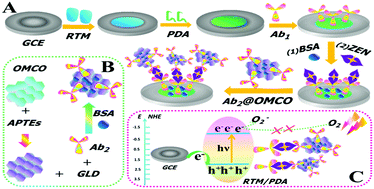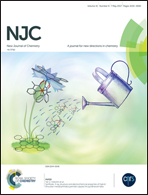Self-enhanced photocathodic matrix based on poly-dopamine sensitized TiO2 mesocrystals for mycotoxin detection assisted by a dual amplificatory nanotag†
Abstract
The photoelectrochemical performance of rutile TiO2 mesocrystals has been demonstrated to be significantly improved by a chelating-assembly of poly-dopamine on the surface of the TiO2 mesocrystals. The formed benzoquinone groups on poly-dopamine could act as electron receivers to take over the photo-induced electrons of TiO2 mesocrystals, thereby constituting a self-reinforced functionality transducing interface to enhance the cathode photocurrent. Herein, zearalenone as a representative mycotoxin was used as a model analyte to assist the immunoassay establishment. The bioconjugates of secondary antibody integrated ordered mesoporous Co3O4 were introduced through immunoreaction. The Co3O4, as a powerful scaffold, could load more bioactive molecules due to its mesoporous structure. Owing to the inevitable steric hindrance caused by the bioconjugates, the photo-initiated electrons in the TiO2 mesocrystals/poly-dopamine composite were inaccessible to reduce the oxygen in the electrolyte, thus depressing the photocurrent density. Meanwhile, partial exciting light found it difficult to arrive at the TiO2 mesocrystals due to Co3O4 with a felicitous band gap of 2.07 eV which consumed the partial light energy. Under optimal conditions, this immunosensor had a wide linear range from 10−6 to 20 ng mL−1 for zearalenone detection. The specificity, precision, and reproducibility were satisfactory for this biosensor, which offered a valuable and versatile protocol in photoelectrochemical immunoassay development.



 Please wait while we load your content...
Please wait while we load your content...